Mercury Photos From NASA's Messenger Probe, Part 1: June 2007—March 2011
Mercury's Surface Ice
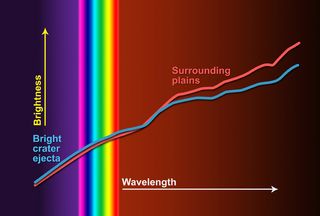
MESSENGER's Mercury Atmospheric and Surface Composition Spectrometer (MASCS) took measurements of the light bouncing off Mercury's surface in different colors to help scientists understand what the soil is made of, and whether ice can exist on the closest planet to the sun. The red and blue lines represent two different points on the planet's surface, and their divergence reveals that different minerals are present in each bit of land.
Mercury's Particle Tails
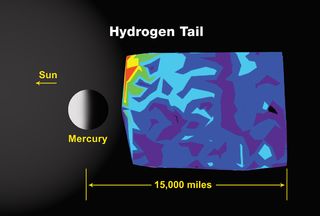
Scientists don't know exactly what creates and shapes the bright tails of particles that stream off the planet's surface. This image from NASA's MESSENGER spacecraft shows Mercury shows the ground track of observations made by the Visible and Infrared Spectrograph, one of the probe's tools for determining surface composition.
Mercury's Pock-marked Surface
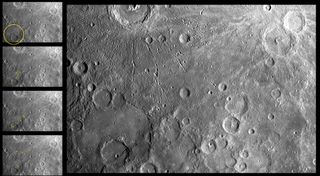
Several processes have acted to sculpt Mercury’s surface over time, and evidence of them is abundant in this image. This scene shows at least five different events in Mercury’s surface history. This image of Mercury’s surface was acquired during MESSENGER’s first flyby of the planet on Jan. 14, 2008, through the lens of the Narrow Angle Camera (NAC), part of the Mercury Dual Imaging System (MDIS).
Mercury Magnetosphere Depiction
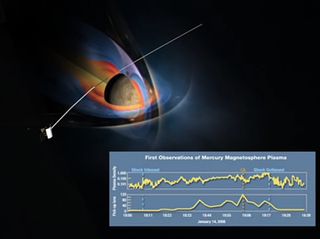
This depiction of a simulated Mercury magnetosphere shows representations of the distortions of the planetary magnetic field lines (blue) by the solar wind. Mariner 10 data showed the first evidence for a magnetic field at Mercury, an unexpected result. The equatorial pass of MESSENGER during quiet solar conditions provided better data than were available from Mariner 10.
Mercury's Hidden Side
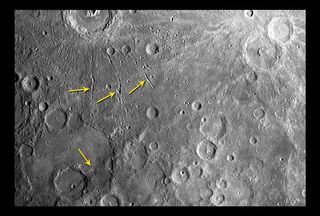
This image of Mercury’s surface was acquired during MESSENGER's first flyby of the planet on Jan. 14, 2008, through the lens of the Narrow Angle Camera (NAC), part of the Mercury Dual Imaging System (MDIS). The image was acquired when MDIS was 11,588 km (7,200 miles) from Mercury’s surface.
Mercury's Volcanoes
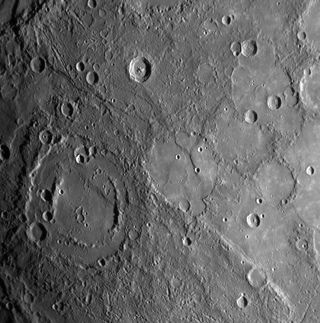
The double-ringed crater on Mercury pictured in the lower left of this image appears to be filled with smooth plains material, perhaps volcanic in nature. The MESSENGER spacecraft took this image during its closest approach to Mercury on Jan. 14, 2008 using its Narrow Angle Camera (NAC) on the Mercury Dual Imaging System (MDIS) instrument.
Mercury's Shrinking Core
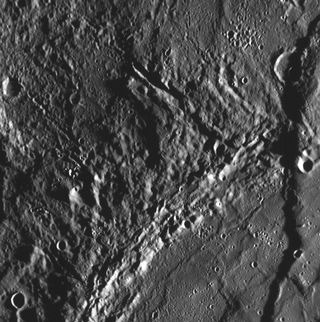
As the MESSENGER team continues to study the high-resolution images taken during the Mercury flyby encounter on Jan. 14, 2008, scarps (cliffs) that extend for long distances are discovered. This frame, taken by the Narrow Angle Camera (NAC) of the Mercury Dual Imaging System (MDIS), shows a region of Mercury's surface previously unseen by spacecraft and a large scarp crossing vertically through the scene, on the far right of the image.
Get the Space.com Newsletter
Breaking space news, the latest updates on rocket launches, skywatching events and more!
Surprise Slosh! Mercury's Core is Liquid
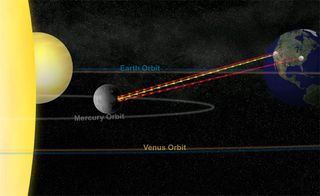
Artistic rendering of the observational geometry. A radar signal (yellow) is transmitted from the Goldstone antenna in California. Radar echoes (red) are received at the Goldstone antenna and at the Robert C. Byrd telescope in Green Bank, West Virginia.
Mercury's Horizon and Craters
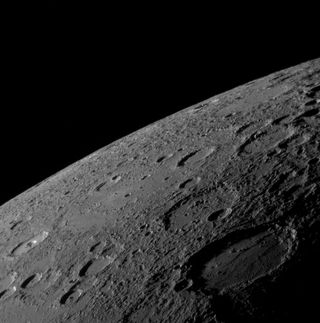
As the MESSENGER spacecraft drew closer to Mercury for its historic first flyby, the spacecraft acquired this mosaic of the sunlit portion of the planet. This image is one of those mosaic frames and was acquired on Jan. 14, 2008, 18:10 UTC, when the spacecraft was about 18,000 kilometers (11,000 miles) from the surface of Mercury.
MESSENGER Coming Close
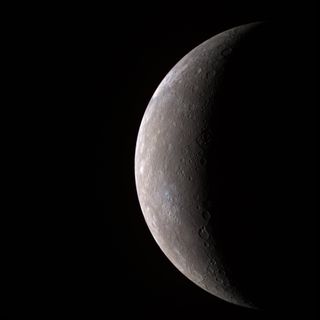
This visible-infrared image shows an incoming view of Mercury, about 80 minutes before MESSENGER's closest pass of the planet on Jan. 14, 2008, from a distance of about 27,000 kilometers (17,000 miles). The color image was generated by combining three separate images taken with different filters.
Join our Space Forums to keep talking space on the latest missions, night sky and more! And if you have a news tip, correction or comment, let us know at: community@space.com.

Space.com is the premier source of space exploration, innovation and astronomy news, chronicling (and celebrating) humanity's ongoing expansion across the final frontier. Originally founded in 1999, Space.com is, and always has been, the passion of writers and editors who are space fans and also trained journalists. Our current news team consists of Editor-in-Chief Tariq Malik; Editor Hanneke Weitering, Senior Space Writer Mike Wall; Senior Writer Meghan Bartels; Senior Writer Chelsea Gohd, Senior Writer Tereza Pultarova and Staff Writer Alexander Cox, focusing on e-commerce. Senior Producer Steve Spaleta oversees our space videos, with Diana Whitcroft as our Social Media Editor.











